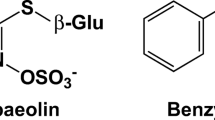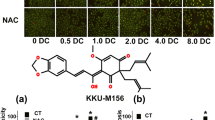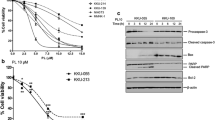Abstract
Phenethyl isothiocyanate (PEITC) is a potential cancer prevention agent that is found in cruciferous vegetables. Previous studies have shown that the effect of PEITC-induced cell death declines rapidly after administration. The metabolic fate of PEITC is modulated by glutathione S-transferases (GST). In this study, we investigated whether GST activity modulates PEITC-induced cytotoxicity on cholangiocarcinoma (CCA) cells. The sensitivity of KKU-M214 and KKU-100 cells to PEITC was associated with GST activity. Two GST inhibitors, ethacrynic acid (EA) and cibacron blue, potentiated the cytotoxic effect of PEITC in CCA cells. PEITC-induced glutathione (GSH) depletion and redox stress, whereas EA itself or in combination with PEITC did not alter GSH redox status. The enhanced cytotoxic effect of EA may be due to inhibition of GST activity. This idea was validated by using siRNA directed against GSTP1 mRNA in KKU-M214 cells, and GSTP1 and GSTT1 mRNA in KKU-100 cells. These GST isoforms were abundantly expressed in the cell lines. Knockdown of GSTs in CCA cell lines potentiated the cytotoxic effect of PEITC. The present study shows that the antitumor effect of PEITC was potentiated by the suppression of GST activity. The inhibition of GST could be a crucial strategy to potentiate chemotherapeutic effect of PEITC on CCA.






Similar content being viewed by others
Abbreviations
- CCA:
-
Cholangiocarcinoma
- PEITC:
-
Phenethyl isothiocyanate
- GSH:
-
Glutathione
- GSSG:
-
Glutathione disulfide
- GSTs:
-
Glutathione S-transferases
- SRB:
-
Sulphorhodamine B
References
Banales JM, Cardinale V, Carpino G, Marzioni M, Andersen JB, Invernizzi P, Lind GE, Folseraas T, Forbes SJ, Fouassier L, Geier A, Calvisi DF, Mertens JC, Trauner M, Benedetti A, Maroni L, Vaquero J, Macias RI, Raggi C, Perugorria MJ, Gaudio E, Boberg KM, Marin JJ, Alvaro D (2016) Expert consensus document: cholangiocarcinoma: current knowledge and future perspectives consensus statement from the European Network for the Study of Cholangiocarcinoma (ENS-CCA). Nat Rev Gastroenterol Hepatol 13:261–280
Buranrat B, Prawan A, Kukongviriyapan U, Kongpetch S, Kukongviriyapan V (2010) Dicoumarol enhances gemcitabine-induced cytotoxicity in high NQO1-expressing cholangiocarcinoma cells. World J Gastroenterol 16:2362–2370
Buranrat B, Prawan A, Sripa B, Kukongviriyapan V (2007) Inflammatory cytokines suppress arylamine N-acetyltransferase 1 in cholangiocarcinoma cells. World J Gastroenterol 16:6219–6225
Chan JM, Wang F, Holly EA (2005) Vegetable and fruit intake and pancreatic cancer in a population-based case-control study in the San Francisco bay area. Cancer Epidemiol Biomark Prev 14:2093–2097
Cheung KL, Kong AN (2010) Molecular targets of dietary phenethyl isothiocyanate and sulforaphane for cancer chemoprevention. AAPS J 12:87–97
Chiao JW, Wu H, Ramaswamy G, Conaway CC, Chung FL, Wang L, Liu D (2004) Ingestion of an isothiocyanate metabolite from cruciferous vegetables inhibits growth of human prostate cancer cell xenografts by apoptosis and cell cycle arrest. Carcinogenesis 25:1403–1408
Chung FL, Morse MA, Eklind KI, Lewis J (1992) Quantitation of human uptake of the anticarcinogen phenethyl isothiocyanate after a watercress meal. Cancer Epidemiol Biomark Prev 1:383–388
Dyba M, Wang A, Noone AM, Goerlitz D, Shields P, Zheng YL, Rivlin R, Chung FL (2010) Metabolism of isothiocyanates in individuals with positive and null GSTT1 and M1 genotypes after drinking watercress juice. Clin Nutr 29:813–818
Griswold KE, Aiyappan NS, Iverson BL, Georgiou G (2006) The evolution of catalytic efficiency and substrate promiscuity in human theta class 1-1 glutathione transferase. J Mol Biol 364:400–410
Honjo S, Srivatanakul P, Sriplung H, Kikukawa H, Hanai S, Uchida K, Todoroki T, Jedpiyawongse A, Kittiwatanachot P, Sripa B, Deerasamee S, Miwa M (2005) Genetic and environmental determinants of risk for cholangiocarcinoma via Opisthorchis viverrini in a densely infested area in Nakhon Phanom, northeast Thailand. Int J Cancer 117:854–860
Keen JH, Jakoby WB (1978) Glutathione transferases. Catalysis of nucleophilic reactions of glutathione. J Biol Chem 253:5654–5657
Khor TO, Cheung WK, Prawan A, Reddy BS, Kong AN (2008) Chemoprevention of familial adenomatous polyposis in Apc(Min/+) mice by phenethyl isothiocyanate (PEITC). Mol Carcinog 47:321–325
Kukongviriyapan V (2012) Genetic polymorphism of drug metabolizing enzymes in association with risk of bile duct cancer. Asian Pac J Cancer Prev 13(Suppl):7–15
Lam TK, Ruczinski I, Helzlsouer KJ, Shugart YY, Caulfield LE, Alberg AJ (2010) Cruciferous vegetable intake and lung cancer risk: a nested case-control study matched on cigarette smoking. Cancer Epidemiol Biomark Prev 19:2534–2540
London SJ, Yuan JM, Chung FL, Gao YT, Coetzee GA, Ross RK, Yu MC (2000) Isothiocyanates, glutathione S-transferase M1 and T1 polymorphisms, and lung-cancer risk: a prospective study of men in Shanghai, China. Lancet 356:724–729
Mannervik B, Alin P, Guthenberg C, Jensson H, Tahir MK, Warholm M, Jornvall H (1985) Identification of three classes of cytosolic glutathione transferase common to several mammalian species: correlation between structural data and enzymatic properties. Proc Natl Acad Sci U S A 82:7202–7206
Meyer DJ, Crease DJ, Ketterer B (1995) Forward and reverse catalysis and product sequestration by human glutathione S-transferases in the reaction of GSH with dietary aralkyl isothiocyanates. Biochem J 306(Pt 2):565–569
Mi L, Di Pasqua AJ, Chung FL (2011) Proteins as binding targets of isothiocyanates in cancer prevention. Carcinogenesis 32:1405–1413
Nakajima T, Takayama T, Miyanishi K, Nobuoka A, Hayashi T, Abe T, Kato J, Sakon K, Naniwa Y, Tanabe H, Niitsu Y (2003) Reversal of multiple drug resistance in cholangiocarcinoma by the glutathione S-transferase-pi-specific inhibitor O1-hexadecyl-gamma-glutamyl-S-benzylcysteinyl-D-phenylglycine ethylester. J Pharmacol Exp Ther 306:861–869
Niwa Y, Hirose K, Nakanishi T, Nawa A, Kuzuya K, Tajima K, Hamajima N (2005) Association of the NAD(P)H: quinone oxidoreductase C609T polymorphism and the risk of cervical cancer in Japanese subjects. Gynecol Oncol 96:423–429
Patel T (2011) Cholangiocarcinoma--controversies and challenges. Nat Rev Gastroenterol Hepatol 8:189–200
Ploemen JH, van Ommen B, van Bladeren PJ (1990) Inhibition of rat and human glutathione S-transferase isoenzymes by ethacrynic acid and its glutathione conjugate. Biochem Pharmacol 40:1631–1635
Rhodes T, Twentyman PR (1992) A study of ethacrynic acid as a potential modifier of melphalan and cisplatin sensitivity in human lung cancer parental and drug-resistant cell lines. Br J Cancer 65:684–690
Shokeer A, Mannervik B (2010) Residue 234 is a master switch of the alternative-substrate activity profile of human and rodent theta class glutathione transferase T1-1. Biochim Biophys Acta 1800:466–473
Sripa B, Leungwattanawanit S, Nitta T, Wongkham C, Bhudhisawasdi V, Puapairoj A, Sripa C, Miwa M (2005) Establishment and characterization of an opisthorchiasis-associated cholangiocarcinoma cell line (KKU-100). World J Gastroenterol 11:3392–3397
Stavrovskaya AA (2000) Cellular mechanisms of multidrug resistance of tumor cells. Biochemistry (Mosc) 65:95–106
Suphim B, Prawan A, Kukongviriyapan U, Kongpetch S, Buranrat B, Kukongviriyapan V (2010) Redox modulation and human bile duct cancer inhibition by curcumin. Food Chem Toxicol 48:2265–2272
Tahir MK, Guthenberg C, Mannervik B (1985) Inhibitors for distinction of three types of human glutathione transferase. FEBS Lett 181:249–252
Townsend DM, Tew KD (2003) The role of glutathione-S-transferase in anti-cancer drug resistance. Oncogene 22:7369–7375
Tusskorn O, Prawan A, Senggunprai L, Kukongviriyapan U, Kukongviriyapan V (2013a) Phenethyl isothiocyanate induces apoptosis of cholangiocarcinoma cells through interruption of glutathione and mitochondrial pathway. Naunyn Schmiedeberg's Arch Pharmacol 386:1009–1016
Tusskorn O, Senggunprai L, Prawan A, Kukongviriyapan U, Kukongviriyapan V (2013b) Phenethyl isothiocyanate induces calcium mobilization and mitochondrial cell death pathway in cholangiocarcinoma KKU-M214 cells. BMC Cancer 13:571
Verlingue L, Malka D, Allorant A, Massard C, Ferte C, Lacroix L, Rouleau E, Auger N, Ngo M, Nicotra C, De Baere T, Tselikas L, Ba B, Michiels S, Scoazec JY, Boige V, Ducreux M, Soria JC, Hollebecque A (2017) Precision medicine for patients with advanced biliary tract cancers: an effective strategy within the prospective MOSCATO-01 trial. Eur J Cancer 87:122–130
Whitbread AK, Masoumi A, Tetlow N, Schmuck E, Coggan M, Board PG (2005) Characterization of the omega class of glutathione transferases. Methods Enzymol 401:78–99
Xiao D, Powolny AA, Moura MB, Kelley EE, Bommareddy A, Kim SH, Hahm ER, Normolle D, Van Houten B, Singh SV (2010) Phenethyl isothiocyanate inhibits oxidative phosphorylation to trigger reactive oxygen species-mediated death of human prostate cancer cells. J Biol Chem 285:26558–26569
Yang CM, Carlson GP (1990) Glutathione conjugation in the isolated perfused rabbit lung: the effects of carbon monoxide, buthionine sulfoximine and cibacron blue. Toxicol Lett 52:47–53
Zhang Y (2012) The molecular basis that unifies the metabolism, cellular uptake and chemopreventive activities of dietary isothiocyanates. Carcinogenesis 33:2–9
Zhang Y, Kolm RH, Mannervik B, Talalay P (1995) Reversible conjugation of isothiocyanates with glutathione catalyzed by human glutathione transferases. Biochem Biophys Res Commun 206:748–755
Acknowledgements
We would like to acknowledge Dr. Justin Thomas Reese for editing the manuscript via Publication Clinic KKU.
Funding
This work was supported by grant-in-aid from Khon Kaen University and National Research Council of Thailand, Cholangiocarcinoma Research Institute, Khon Kaen University.
Author information
Authors and Affiliations
Corresponding author
Ethics declarations
Conflict of interest
The authors declare that they have no conflicts of interest.
Rights and permissions
About this article
Cite this article
Tusskorn, O., Khunluck, T., Prawan, A. et al. Suppression of glutathione S-transferases potentiates the cytotoxic effect of phenethyl isothiocyanate in cholangiocarcinoma cells. Naunyn-Schmiedeberg's Arch Pharmacol 391, 657–667 (2018). https://doi.org/10.1007/s00210-018-1492-6
Received:
Accepted:
Published:
Issue Date:
DOI: https://doi.org/10.1007/s00210-018-1492-6




